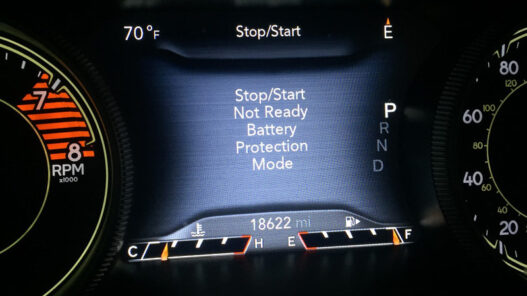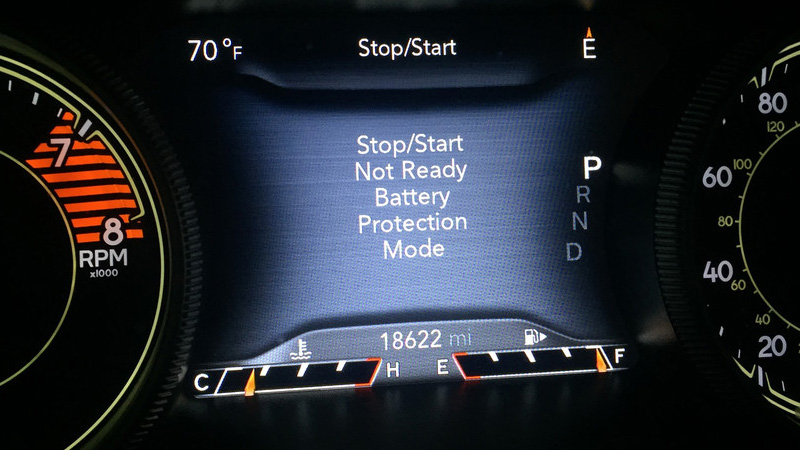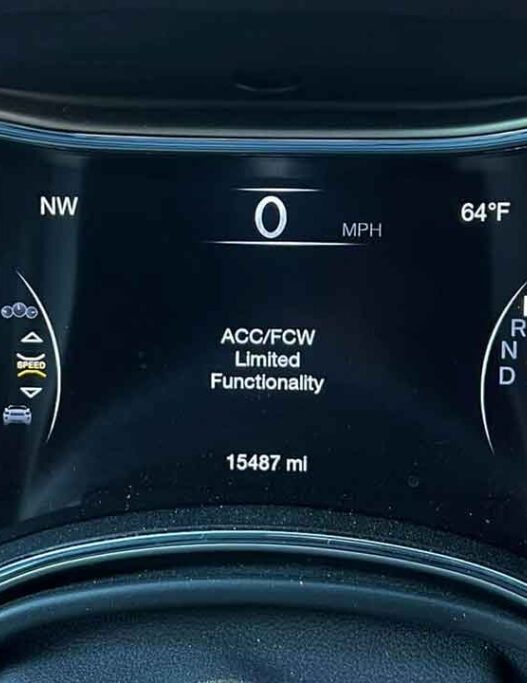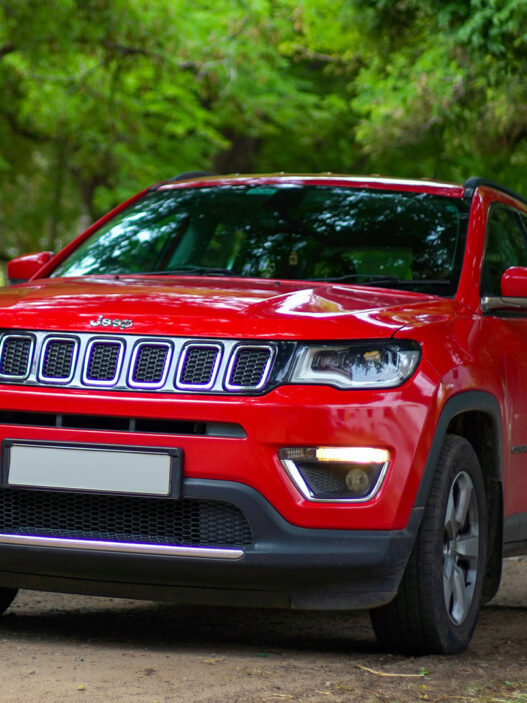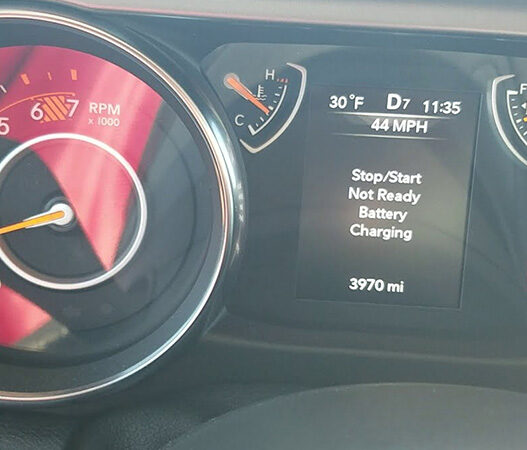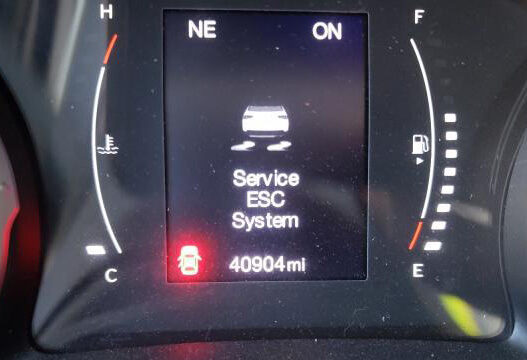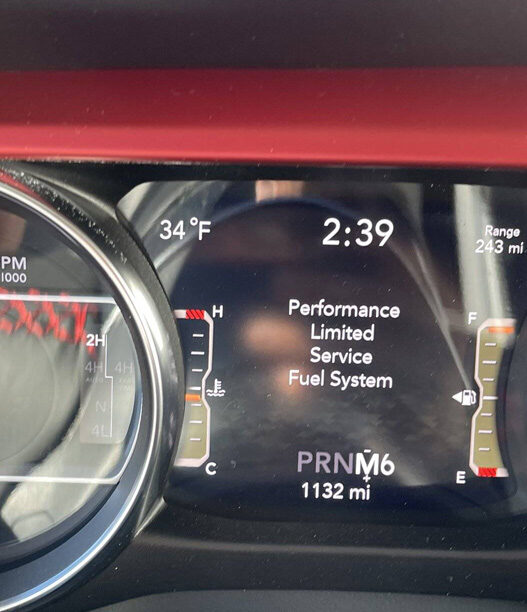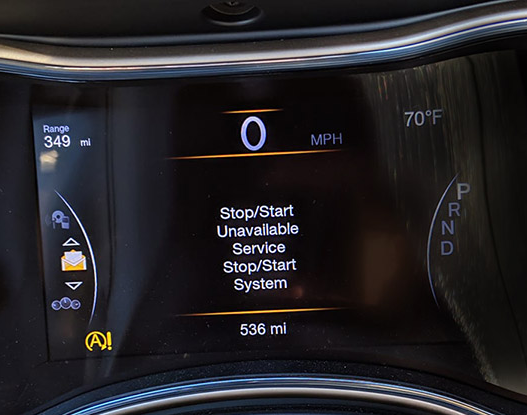Jeep’s fuel-saving stop/start system functions by automatically turning off the engine when braking to a stop. Nevertheless, the sudden engine shutdowns and rapid restarts can exert significant strain on the vehicle’s electrical components and you see Stop/Start Not Ready Battery Protection Mode.
In the event that the system switches to battery protection mode, it deactivates the stop/start feature to prevent battery depletion. However, the continual presence of warning indicators and the absence of automatic engine stoppage result in wasted fuel and decreased fuel efficiency.
Identifying the reason behind the activation of the “Stop/Start Not Ready Battery Protection Mode” and carrying out necessary repairs is essential to restore the functionality of Jeep’s stop/start system. Once fixed, the resumption of automatic engine shutdowns at traffic stops can lead to enhanced miles per gallon and reduced operational expenses.
By systematically troubleshooting the issue, you can pinpoint and rectify the underlying cause of the “Stop Start not Ready Battery Protection Mode” activation in your Jeep. Addressing weaknesses in the electrical system, charging irregularities, or component malfunctions is crucial for the restoration of stop/start functionality, ultimately optimizing efficiency.
Let’s delve into a detailed analysis of the factors contributing to this problem and explore potential solutions!
What is the Stop/Start System & Battery Protection Mode?
The stop/start system in Jeep vehicles uses a more powerful starter motor and enhanced battery to manage the greater demands of repeated starting and stopping. Various sensors keep track of battery levels, temperatures, and speed of the vehicle in order to decide when it is suitable for the auto-stop feature to engage. The engine quickly restarts once the brake pedal is released.
If specific conditions are not ideal, the system goes into a protective mode to safeguard the battery, disabling the stop/start function to avoid draining or harming the battery.
By understanding the cause of this protective mode, adjustments can be made to restore the stop/start functionality.
Indication of a Not Ready Battery Protection Mode
Several signs suggest that your Jeep has activated the start/stop not ready battery protection mode and deactivated the auto-stop feature: – The stop/start indicator light on the gauge cluster will flash continuously instead of showing a solid green light within 10-15 seconds of starting the engine. – The engine will not automatically turn off when coming to a complete stop at traffic lights or stop signs.
- Warning lights may appear on the dashboard indicating issues with the battery or charging system, such as the battery light, check engine light, or alerts for high/low voltage.
- The auto stop time displayed on the information cluster screen, which tracks the total engine shutdown time for calculating mileage impact, will stop increasing when the stop/start function is no longer operational.
- During longer trips, the average fuel consumption reading may suddenly appear higher than usual due to the loss of efficiency gains from the stop/start feature.
By recognizing these signs of the not-ready battery protection mode early on, you can identify the issue and troubleshoot the specific parameter that triggered the preservation status. Restoring the system’s functionality will help maximize MPG benefits.
Stop/Start Not Ready Battery Protection Mode: 8 Causes & Fixes
There are a few typical culprits for stop/start not ready activation:
1. Low Battery Charge
Cause
The battery charge may be too low for the Stop/Start system to function. This can happen due to a variety of reasons, such as infrequent driving, short trips that don’t allow the battery to fully recharge, or leaving electrical accessories on when the engine is off. When the battery is not sufficiently charged, the vehicle’s system prioritizes critical functions over the Stop/Start feature, leading to the “Stop/Start Not Ready Battery Protection Mode” message.
By addressing these potential causes and implementing the corresponding fixes, you can help ensure that the Stop/Start system in your Jeep functions correctly and efficiently. If the problem persists, consulting a professional mechanic or a Jeep dealership for further diagnostics and repairs is recommended.
Solution and Fix
Fully Charge the Battery: Use a battery charger to bring the battery back to full charge. This can be done by connecting the charger to the battery terminals and following the manufacturer’s instructions. Ensure the charger is set to the correct voltage (typically 12 volts for most car batteries). Allow the charger to complete its cycle, which may take several hours.
Regular Driving: Drive the vehicle for longer periods to give the alternator enough time to recharge the battery fully. Plan occasional longer trips, especially if you frequently take short trips. A continuous drive of at least 20-30 minutes can help recharge the battery.
Use a Battery Maintainer: If the vehicle is not driven often, use a battery maintainer or trickle charger to keep the battery at an optimal charge level. Connect the maintainer to the battery when the vehicle is parked for extended periods. This device will keep the battery charged without overcharging it.
Check for Parasitic Drains: Ensure there are no electrical components or accessories draining the battery when the vehicle is off. Use a multimeter to check for parasitic drains by measuring the current draw when the vehicle is off. If an excessive draw is found, locate and repair the source of the drain.
Battery Health Check: Regularly check the health of the battery to ensure it can hold a charge. Use a battery tester or take the vehicle to a service center for a battery health check. If the battery fails the test, consider replacing it.
Replace the Battery: If the battery is unable to hold a charge despite attempts to recharge it, replacement may be necessary. Purchase a new battery that meets the specifications for your Jeep. Disconnect the old battery, remove it from the vehicle, and install the new battery, ensuring all connections are secure.
2. Battery Age and Wear
Cause
Over time, car batteries naturally degrade and lose their ability to hold a charge and deliver the necessary power. This aging process can be accelerated by various factors such as frequent short trips, extreme temperatures, and lack of regular maintenance.
An aged or worn-out battery may not provide sufficient power for the Stop/Start system to function, leading to the “Stop/Start Not Ready Battery Protection Mode” message.
Solution and Fix
Regular Battery Inspections: Periodically check the battery for signs of wear and aging. Inspect the battery for physical signs of aging, such as corrosion on terminals, bulging sides, or leaks. Ensure the battery is securely mounted and that connections are tight.
Battery Health Testing: Test the battery’s health and performance regularly. Use a battery tester or take the vehicle to a service center for a comprehensive battery health check. These tests measure the battery’s voltage, cold cranking amps (CCA), and overall ability to hold a charge.
Monitor Battery Age: Keep track of the battery’s age and typical lifespan. Most car batteries have a lifespan of 3-5 years. If your battery is within or beyond this range, it may be time to consider a replacement. Check the manufacture date, which is usually printed on the battery.
Replace the Battery: Replace the battery if it is old or shows signs of significant wear. Purchase a new battery that meets the specifications for your Jeep. Disconnect the negative terminal first, followed by the positive terminal, remove the old battery, and install the new battery by connecting the positive terminal first, then the negative terminal. Ensure all connections are tight and secure.
Choose the Right Battery: Ensure the replacement battery meets your vehicle’s requirements. Refer to your vehicle’s owner’s manual for the correct battery specifications, including size, type, and CCA rating. Selecting the correct battery ensures compatibility with your vehicle’s electrical system and optimal performance of the Stop/Start system.
Proper Battery Maintenance: Maintain the battery to extend its lifespan and efficiency. Regularly clean the battery terminals to prevent corrosion, ensure the battery is properly secured to avoid vibrations, and check the electrolyte levels if applicable (some batteries are maintenance-free). During regular vehicle service, have the battery checked and serviced as needed.
Preventative Measures: Adopt practices that reduce strain on the battery. Avoid frequent short trips that don’t allow the battery to recharge fully, reduce the use of high-power accessories when the engine is off, and park the vehicle in a garage or shaded area to protect the battery from extreme temperatures.
By monitoring the age and condition of your battery and replacing it when necessary, you can help ensure that the Stop/Start system operates reliably. This proactive approach reduces the likelihood of encountering the “Stop/Start Not Ready Battery Protection Mode” message and helps maintain overall vehicle performance.
3. Frequent Short Trips
Cause
Frequent short trips can prevent the battery from fully recharging. Each time you start your Jeep, a significant amount of power is drawn from the battery. If the engine is not run long enough to recharge the battery fully, over time, this can lead to a continually undercharged battery.
This condition can trigger the “Stop/Start Not Ready Battery Protection Mode” message, as the system prioritizes maintaining critical battery charge over enabling the Stop/Start functionality.
Solution and Fix
To mitigate the effects of frequent short trips on your Jeep’s battery, plan regular longer drives of at least 20-30 minutes, especially on highways or open roads. These longer trips allow the alternator sufficient time to recharge the battery fully. Additionally, use a battery maintainer or trickle charger when the vehicle is parked for extended periods, particularly if you frequently take short trips. This device will help keep the battery at an optimal charge level without overcharging it.
Reduce the use of high-power electrical accessories such as heated seats, rear defrosters, and infotainment systems during short trips to minimize the battery’s discharge rate. Combine multiple short trips into a single longer trip whenever possible to reduce the frequency of battery drain. Avoid excessive idling by turning off the engine when parked or waiting for extended periods, as idling does not effectively recharge the battery.
Regularly monitor the battery’s charge level using a battery tester and include battery checks in your routine vehicle maintenance. If the battery charge is consistently low, take longer drives more frequently or use a battery maintainer. If short trips are unavoidable, consider upgrading to a higher-capacity battery that can provide more reserve power and handle the demands of frequent short trips better. This proactive approach will help ensure the Stop/Start system functions properly and maintain the overall health of your vehicle’s battery.
By adopting these practices, you can help maintain the battery’s charge and ensure the Stop/Start system functions properly. This proactive approach helps avoid the “Stop/Start Not Ready Battery Protection Mode” message and contributes to the overall longevity and reliability of your vehicle’s battery and electrical systems.
4. Parasitic Battery Drain
Cause
Parasitic battery drain occurs when an electrical component or system continues to draw power from the battery even when the vehicle is turned off. This continuous power draw can deplete the battery over time, leading to insufficient charge for the Stop/Start system to function properly.
Common culprits include malfunctioning electronic devices, faulty wiring, or aftermarket accessories that are not properly integrated into the vehicle’s electrical system.
Solution and Fix
Identify the Drain: Use a multimeter to measure the current draw from the battery when the vehicle is turned off. Ensure the vehicle is completely turned off and that all doors are closed. Disconnect the negative battery terminal and connect the multimeter in series between the negative battery terminal and the negative battery cable.
Isolate the Circuit: Identify which circuit is causing the excessive drain by pulling fuses one at a time. When the current draw drops to an acceptable level, you have identified the circuit causing the drain. Note which fuse caused the change and refer to the vehicle’s manual to identify the associated circuit.
Inspect and Repair: Inspect the wiring and components associated with the problematic circuit for any signs of malfunction. Look for damaged or frayed wires, corroded connectors, or malfunctioning components within the identified circuit.
Check Aftermarket Accessories: Evaluate any aftermarket accessories installed in the vehicle, such as alarms, audio systems, or lighting, to ensure they are properly integrated. Disconnect aftermarket accessories one at a time to see if the parasitic draw decreases. If an accessory is found to be the cause, it may need to be rewired, replaced, or removed.
Professional Diagnosis: Seek assistance from a professional mechanic or auto electrician if the source of the drain is not easily identifiable. A professional can use specialized tools and techniques to diagnose complex electrical issues and accurately pinpoint the source of the parasitic drain.
Regular Monitoring: Regularly monitor the battery’s charge and health to catch any issues early. Use a battery tester or have your battery checked during routine maintenance to ensure it is holding a charge properly.
5. Faulty Battery Sensor
Cause
The battery sensor, also known as the battery management sensor or intelligent battery sensor (IBS), monitors the battery’s state of charge, health, and power usage. A faulty battery sensor can provide incorrect data to the vehicle’s computer system, leading to inaccurate assessments of the battery’s condition.
This can result in the Stop/Start system being disabled as a protective measure, as the system may believe the battery is not capable of handling the additional load.
Solution and Fix
To address a faulty battery sensor in your Jeep, begin by using diagnostic tools to check for error codes and irregular readings from the battery management system. Conduct a visual inspection for any signs of damage or corrosion on the sensor and its connections. Use a multimeter to test the sensor’s voltage output against the vehicle’s specifications. If the readings are abnormal, inspect the wiring harness for wear, damage, or loose connections, and clean any corroded terminals with a wire brush, applying dielectric grease to prevent future corrosion.
If the sensor is confirmed faulty, replace it with a new, compatible battery sensor. Disconnect the negative battery terminal to avoid electrical short circuits during replacement. Install the new sensor, ensuring all connections are secure, and reconnect the battery terminal. Reset the vehicle’s computer system using a diagnostic scanner to clear any error codes and update the system with the new sensor data. Regularly monitor the sensor’s performance during routine maintenance to ensure it continues to function correctly and maintains the proper operation of the Stop/Start system.
6. Corroded Battery Terminals
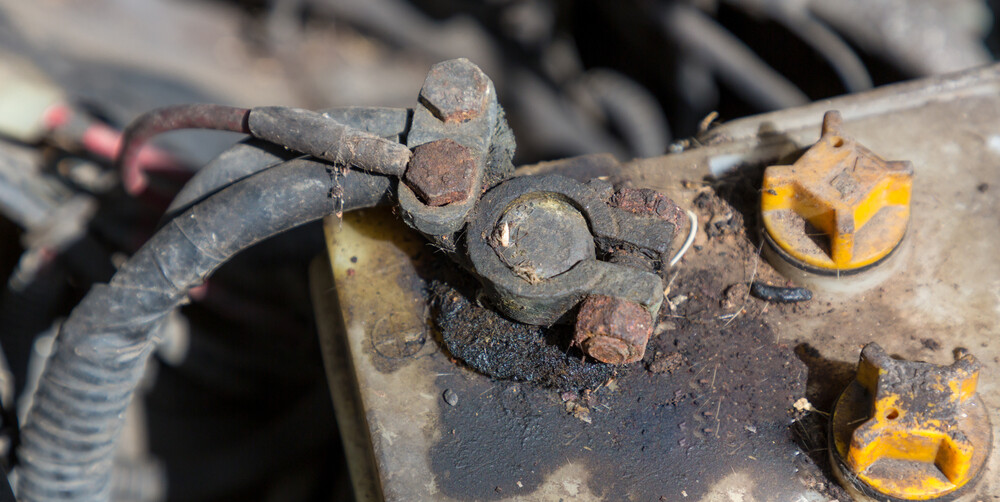
Cause
Corroded battery terminals can impede the flow of electricity between the battery and the vehicle’s electrical system. This can prevent the battery from charging properly and delivering sufficient power to the vehicle’s systems, including the Stop/Start system.
Corrosion typically appears as a white, ashy substance on the battery terminals and is often caused by exposure to battery acid, moisture, or dirt.
Solution and Fix
To address corroded battery terminals in your Jeep, start by regularly inspecting the terminals for signs of corrosion, such as white, blue, or greenish deposits. If corrosion is present, disconnect the battery cables, beginning with the negative terminal to prevent short circuits. Clean the terminals using a solution of baking soda and water, scrubbing away the corrosion with a wire brush or battery terminal cleaner. Rinse with clean water and dry thoroughly. After cleaning, apply a thin layer of petroleum jelly or dielectric grease to the terminals to prevent future corrosion and reconnect the battery cables, ensuring a secure connection.
To maintain battery health and prevent future issues, perform regular checks on the battery terminals during routine vehicle maintenance. Clean any minor corrosion promptly and ensure the battery is securely mounted to avoid excessive vibrations. Additionally, consider using anti-corrosion washers or battery terminal protectors for added protection.
By keeping the terminals clean and well-maintained, you ensure that the battery can provide sufficient power to all vehicle systems, including the Stop/Start system, thus preventing the “Stop/Start Not Ready Battery Protection Mode” message and ensuring reliable vehicle performance.
By regularly inspecting and cleaning the battery terminals, you can prevent corrosion from affecting the electrical connections in your Jeep. This ensures that the battery can maintain a proper charge and deliver sufficient power to all vehicle systems, including the Stop/Start system, thereby avoiding the “Stop/Start Not Ready Battery Protection Mode” message and ensuring reliable vehicle performance.
7. High Electrical Load
Cause
A high electrical load occurs when numerous electrical accessories and systems draw power from the battery simultaneously. This can overwhelm the battery and the alternator, leading to insufficient charge for critical systems like the Stop/Start function.
High electrical demand can result from using features such as heated seats, air conditioning, infotainment systems, headlights, and other power-hungry accessories, especially when the vehicle is idling or making short trips. This excessive drain can cause the vehicle to enter “Stop/Start Not Ready Battery Protection Mode.”
Solution and Fix
Identify High-Load Accessories: Determine which electrical accessories and systems are contributing to the high load on the battery. List all electrical components that are frequently used, especially those with high power consumption like heated seats, air conditioning, infotainment systems, and auxiliary lighting.
Upgrade to Energy-Efficient Accessories: Replace older, power-hungry accessories with more energy-efficient alternatives. Consider upgrading to LED lighting, which consumes less power than traditional halogen bulbs.
Install a Higher Capacity Alternator: Upgrade to a higher capacity alternator if the vehicle’s electrical demand consistently exceeds the current alternator’s output. Consult with a professional mechanic to determine if a higher capacity alternator is necessary and compatible with your vehicle.
Use a Dual Battery System: Install a dual battery system to manage high electrical loads more effectively. A dual battery system includes a secondary battery dedicated to powering accessories, leaving the primary battery for essential vehicle functions.
Monitor Electrical Load: Keep track of the vehicle’s electrical load and make adjustments as necessary. Use a vehicle diagnostic tool to monitor the electrical load and battery performance. Pay attention to any warning lights or messages related to the electrical system.
8. Software Glitches

Cause
Software glitches within the vehicle’s control modules can interfere with the proper functioning of the Stop/Start system. These glitches can arise from outdated software, bugs in the current software version, or conflicts between different software modules. When the vehicle’s software does not operate as intended, it can misinterpret data from sensors and systems, leading to the “Stop/Start Not Ready Battery Protection Mode” message.
Solution and Fix
To fix software glitches affecting the Stop/Start system in your Jeep, start by using a diagnostic tool to identify any software-related error codes. Ensure the vehicle’s software is up to date by visiting a certified Jeep dealership or authorized service center for updates. Perform a soft reset by disconnecting the negative battery terminal for 15 minutes to clear temporary glitches, and if necessary, conduct a factory reset or reprogram the control modules with the latest software.
Regularly check for software recalls or service bulletins, and monitor the system’s performance after any updates. If issues persist, seek professional diagnosis and repair from a certified mechanic or dealership.
By addressing software glitches through updates, resets, and professional diagnostics, you can ensure that the Stop/Start system operates as intended. Keeping the vehicle’s software current and resolving any conflicts or bugs will help prevent the “Stop/Start Not Ready Battery Protection Mode” message and maintain the overall performance of your Jeep’s electronic systems.
Preventing Future Activation: Taking a Proactive Approach
After fixing the root cause of the issue, it is important to implement proactive measures to ensure the reliable functioning of your Jeep’s stop/start system by:
1. Maintaining the Electrical System
Adhere to the recommended charging system inspection intervals provided by the manufacturer. Regularly check the belt tension, alternator output, and conduct battery load tests. Conduct voltage drop tests on cables annually to detect and address any minor issues before they escalate into major failures.
2. Allowing Sufficient Warm-Up Time
During cold weather conditions, drive gently for a minimum of 8-10 minutes before engaging the stop/start function. Ensure that the engine, battery, and cabin reach their optimal operating temperatures to prevent premature cycling.
3. Considering an Upgraded Battery
If the original battery is not suitable for your driving habits, consider installing a higher-capacity AGM battery specifically designed for stop/start systems. Look for a battery with at least 800 cold crank amps and a reserve capacity of over 150 minutes.
4. Driving Smoothly
Avoid aggressive acceleration and braking just before coming to a stop, as this can strain the charging system. Drive steadily with gradual speed changes to maximize fuel efficiency. Begin easing off the accelerator well in advance of stops.”
Final Words
When the stop/start system of your Jeep becomes stuck in ‘Stop/Start Not Ready Battery Protection Mode,’ it results in bothersome warning indicators and fuel wastage while idling. By identifying and addressing the root cause of the electrical or charging issue that triggers this mode, you can carry out specific repairs.
Restoring full functionality to the stop/start system enables you to utilize the automatic shutdowns and restarts for enhanced fuel efficiency and cost savings.
It is essential to maintain the electrical components of your Jeep, allow sufficient warm-up time, and drive smoothly to prevent future activation of the ‘Stop/Start Not Ready Battery Protection Mode’ in your Jeep. By ensuring that the stop/start technology operates effectively, your Jeep will maximize its fuel-saving advantages.







